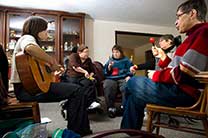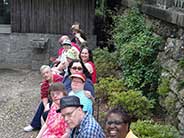The process of obtaining a house is much the same whether your family and the families you’re working with will be renting or purchasing a home. In this section, you’ll learn more about the important first steps in the house hunting process:
Set a Budget
Three separate budgets are helpful when planning for a home. The first budget addresses initial purchase or rental costs. The second budget provides for ongoing care and upkeep of the home and residents’ daily/monthly living expenses. Developing the second, ongoing budget prior to a purchase decision helps ensure that the monthly expenses of the home will be affordable for the residents. Such a budget is also needed when one is renting rather than buying a residence.
A third budget is for support services and should be considered in terms of overall personal funds available, but otherwise these costs should be separate from the first two budgets. Therefore the support services budget is not detailed here.
Learn more about creating a support services budget
When Renting — 1st Budget
When renting, the first budget must include the initial costs of the rental. Keep in mind that the following may be subject to change based on the landlord’s requirements of the property you choose:
- Deposit and at least first month’s rent (some landlords may require the first and last month’s rent)
- Renovations for accessibility
- Utility deposits
- Common area furnishings
When Purchasing — 1st Budget
Besides the actual cost of the home, this first budget must include:
- Fees paid to housing corporation or development company
- Legal fees
- Down payment (5–20% of purchase price)
- Closing costs (1–2% of purchase price)
- Repairs and renovations
- Common area furnishings
- Utility deposits
Sample 1st Budget (For 4 People)
| House Purchase Cost | |
|---|---|
| Purchase | $174,000 |
| Renovations | $10,000 |
| Development Fee | $2,000 – $10,000 |
| Legal Fees | $750 |
| Closing Costs | $1,000 |
| Utilities | $300 |
| Misc. | $250 |
| Common Area Furnishings | $4,000 |
| Total Cost (approximate) | $192,300-$200,300 |
2nd Budget — Ongoing Costs
There are daily and monthly ongoing costs that you can plan and save for.
Daily/monthly ongoing costs include:
- Monthly mortgage or rent
- Property tax (for purchase)
- Homeowners’ or renters’ insurance
- Utilities:
- Gas
- Electric
- Water & sewer
- Garbage
- Phone (cell phone and/or landline)
- Cable, optional
- Internet, optional
- Security system monitoring, optional
- Home maintenance (for Purchasing only):
- Condo or home-owner’s association dues
- Management fees (if using a property management organization)
- Snow removal & lawn care
- Capital replacement (roof, carpet, furnace, and so on)
- Routine maintenance: When renting, the maintenance responsibility will be less, but consider if assistance will be necessary.
- Food and household supplies
- Transportation and parking fees
- Recreation
Sample 2nd Budget – Ongoing Costs for 4 People
| Monthly Operating Expenses | Cost | Per Family |
|---|---|---|
| Utilities (including phone and cable) Food and household supplies | $450 | |
| Recreation | $700 | |
| Transportation (reimburse car use) | $100 | |
| Miscellaneous | $75 | |
| Total General | $1,425 | $356.25 |
| Home Maintenance | ||
| Snow removal & lawn care | $80-$150 | |
| Routine maintenance | $250 | |
| Capital replacement | $175 | |
| Management Fee (if working with a housing corporation) | $185 | |
| Total Maintenance | $690 | $172.50 |
| Total Monthly Expenses | $2,115 | $528.75 |
Save Ahead
Save ahead for the most common and most expensive ongoing costs by doing the following:
- Create a monthly home maintenance allowance: Set aside money each month for expected and unexpected maintenance and repair
- Create a capital reserve account: This can be calculated by dividing the cost of appliances and household fixtures (furnace, water heater) by the expected life of each item. This amount should be saved per year.
- Prepare for cost of utilities: Once you have a chosen property in mind, contact utility companies for the rate paid by the previous owner in the last year. Then compare the previous owner’s usage to the expected use of the current residents and make adjustments. Factor this into your budget, or see if the utility company can offer a fixed monthly rate.
Sample Mortgage Costs
The down payment and monthly cost of mortgage payments to each family will, of course, depend on the down payment and terms of the mortgage. Here are some examples.
| Mortgage Costs | ||||||||
|---|---|---|---|---|---|---|---|---|
| Interest | 7% | 7% | 8% | 8% | 7% | 7% | 8% | 8% |
| Term Length (years) | 15 | 30 | 15 | 30 | 15 | 30 | 15 | 30 |
| Down payment | – | – | – | – | $40,000 | $40,000 | $40,000 | $40,000 |
| Financed | $200,000 | $200,000 | $200,000 | $200,000 | $160,000 | $160,000 | $160,000 | $160,000 |
| Monthly payment | $1,797.66 | $1,467.53 | $1,911.30 | $1,330.60 | $1,438.13 | $1,064.48 | $1,529.04 | $1,174.02 |
| Property tax | $325.00 | $325.00 | $325.00 | $325.00 | $325.00 | $325.00 | $325.00 | $325.00 |
| Insurance | $100.00 | $100.00 | $100.00 | $100.00 | $100.00 | $100.00 | $100.00 | $100.00 |
| Total mortgage | $2,222.66 | $1,892.53 | $2,336.30 | $1,755.60 | $1,863.13 | $1,489.48 | $1,954.04 | $1,599.02 |
| Cost Per Family | ||||||||
| Mortgage | $555.67 | $473.13 | $584.08 | $438.90 | $465.78 | $372.37 | $488.51 | $399.76 |
| Expenses | $515.00 | $515.00 | $515.00 | $515.00 | $515.00 | $515.00 | $515.00 | $515.00 |
| Total per month | $1,070.67 | $988.13 | $1,099.08 | $953.90 | $980.78 | $887.37 | $1,003.51 | $914.76 |
Get a Real Estate Agent
You may have already considered important aspects of a house hunt such as location, accessibility needs, and nearby transportation, when planning for your child’s future and when finding compatible housemates. Working with a real estate agent, whether renting or purchasing, can help all families involved make a house hunting strategy and find the right place. Working with an agent as soon as you have your budgets will help save time, effort, and potentially money.
Finding the Right Agent
- Get Recommendations: The families should decide together which real estate company to use and how to choose a specific agent. You might consider:
- Using an agent that you or another family in your group has used in the past
- Getting recommendations from families who have formed family-directed housing
- Consider Using a Housing Corporation: Housing Corporations develop and maintain housing for people with disabilities, and such companies have experience in buying homes for persons with disabilities. Although services from a housing corporation or development company may add cost initially, they can save substantial work and may be cost effective in the long run.
- Choose a Contact Person: One person from your group should be designated to communicate with the real estate agent. This will expedite the process and prevent miscommunication.
- Interview and Decide: The contact person should set up group meetings with potential agents and/or housing corporations. Then, the right agent should be elected as a group.
What a Real Estate Agent Does
The right real estate agent will consider all the needs of each family and resident. He or she will also be an expert in local real estate laws, neighborhood attitudes, and amenities.
An agent will help:
- Create a strategy for looking at homes. One or two members of the group could look at homes initially, or the group could review information to narrow the number of homes the entire group sees. An agent will help coordinate schedules.
- Find the perfect location. This includes each resident’s needs for distance to work or day programs; transportation; the distance from the family homes; access to shopping, entertainment and doctors; the safety and comfort of the neighborhood; amenities such as parks; and convenience for staff.
- Get the best deal. A realtor will negotiate with the seller on your behalf on price, contract terms, closing costs, and final repairs.
Secure Financing
There are many ways to help finance the rental or purchase of your family-directed housing. There are more options for assistance when purchasing a home, and some families have also raised funds through charitable contributions for at least a portion of the home and furnishings.
The list below gives an overview of each type available and what they’re used for.
Mortgage Programs — Purchasing
To borrow money to purchase the home, considerable research is needed. The best mortgage will depend, in part, on who is actually purchasing the home.
Talk to mortgage lenders and housing coalitions in your area to find out more about what may be available.
Each lender may have different options, programs, and discounts.Standard Home Loans:
- Most common, sometimes easiest option for purchasing a home
- Process of getting a loan can be complicated.
- Banks will ask whether the home will be owner-occupied or rented to others. The cost of loans for commercial rental properties is typically higher, because lending institutions assume that if a property is not occupied by the owner, there is a greater possibility it will not be as well maintained.
Reverse Mortgage:
- Option for parents over the age of 62 who own their own home.
- A reverse mortgage is a loan against one’s home that does not have to be paid back for as long as it is occupied.
- The amount that can be borrowed depends on the homeowner’s age, the home’s value and location, and the cost of the loan. The money borrowed can be received in a lump sum or in smaller periodic payments. The money is paid back, with interest, when the last living borrower dies, sells the home, or permanently moves out of the home.
- Income is not a factor in approval for the loan, because a monthly loan payment is not required.
- Costs include: application fees and closing costs (typically paid with loan advances).
- May have tax consequences and can affect eligibility for government benefit programs.
- Available through private lenders and local and state government agencies.
Do Your Research! The AARP offers information on reverse mortgages: www.aarp.org; 1-800-424-3410.
Secondary Mortgage Market:
- More affordable and accessible mortgages to low or middle-income homebuyers.
- Via Fannie Mae and Freddie Mac. These companies do not work directly with homebuyers, but purchase mortgages from lenders and resell them to investors.
- Freddie Mac does not recommend specific lenders, but Fannie Mae (1-800-7FANNIE) does.
Fannie Mae Home Choice Mortgage:
- Specifically designed for people with disabilities.
- Flexibility in: down payments, qualifying debt-to-income ratios, and credit histories.
- Available through approved coalitions of organizations and agencies working together to create home-ownership opportunities for people with disabilities.
- Fannie Mae will provide a list of coalitions in different areas of the country (1-800-7FANNIE).
FHA Loans
- The Department of Housing and Urban Development (HUD) insures loans to help people secure mortgages through the Federal Housing Administration (FHA).
- This encourages lenders to make credit available to people who would not otherwise qualify for conventional loans, such as first-time home buyers or residents of disadvantaged neighborhoods.
- More flexible requirements for down payments, credit histories, and qualifying income. Applications for these loans can be made directly to an FHA-approved lender (www.hud.gov).
Government Housing Vouchers — Both
HUD Vouchers can help with the rental or purchase of a home for low-income people with disabilities. The Public Housing Authority administers most of these programs and applies for funding, then gives the funds to a nonprofit organization. Most such programs are not directly available to individuals.
You must do substantial research and work in conjunction with a government agency or nonprofit organization to take advantage of these programs. The organizations then facilitate purchasing a home for individuals and families with limited financial resources. Some examples of programs include community block grants, the Ohio Housing Trust Fund, and Section 811 Supportive Housing for Persons with Disabilities.
Rentals: Housing Choice Voucher Program (Section 8)
- One of the most commonly used federal programs for housing.
- Can be used when a family member or corporation owns a home.
- The Housing Choice Voucher Program offers several different types of assistance. Federal money funds the program, but local public-housing authorities and some nonprofit organizations administer it.
- Programs and funding vary by area.
- A limited amount of funding is available each year.
- The local Public Housing Authority (PHA) maintains an applicants’ waiting list for Section 8.
Rentals: Tenant-Based Rental Assistance
- Primary type of Section 8 assistance
- People with disabilities and low incomes can receive a subsidy to assist with monthly housing costs.
- The subsidy, provided in the form of a voucher, is used to rent housing of the person’s choice.
- Once a person receives a voucher, he or she looks for an approved apartment or house to rent. The property has to meet certain standards, and the owner has to enter into an agreement with the administering agency.
- The renter pays a portion of the fair-market rent, established by HUD, usually equal to 30% of the family income, and HUD pays the remainder.
- Subsidy based on the cost of moderately priced rental housing in the community.
Rentals: Project-Based Rental Assistance
- A Public Housing Authority is permitted to use up to 20% of its voucher funds for “project-based rental assistance.” In this case, the funding is approved for certain properties for which the PHA has a special agreement with the owner.
- The PHA refers a person on the waiting list for rental assistance vouchers to the property owner.
- If the person moves from the project-based unit, he or she cannot rent another home with the voucher (as one could with tenant-based assistance), but instead would go back on the waiting list.
- Work similarly to tenant-based rental assistance, but are available only to families with a child with disabilities.
- Local PHAs and some nonprofits can receive this funding from HUD.
Rentals: Certain Developments Vouchers and Designated Housing Vouchers
- Specifically designed to counter public housing that is designated “elderly-only.”
- Housing choice vouchers
- The process of applying is the same as for tenant-based vouchers, and individuals and families can still be placed on the waiting list.
- Residents should apply to the Public Housing Authority for a voucher. Then the owner of the home enters into a contract with the PHA. There will be some safety requirements, usually similar to what families would have already considered. The local PHA can be found in the phone book or through HUD.
Purchase: Home Ownership Assistance
- Designed for first-time homebuyers.
- Several additional eligibility rules and some special conditions to accommodate individuals with a disability apply.
- Comes in the form of Section 8 vouchers.
- Local PHAs are not required to offer this assistance, and some do not.
Local and County Programs — Both
Depending on where you live, or where the home will be located, local and/or county programs may be available. Some programs are funded through HUD, while other programs receive state funding or private grants. The city department of community development (or a similar department) and local housing coalitions are good places to research such programs.













